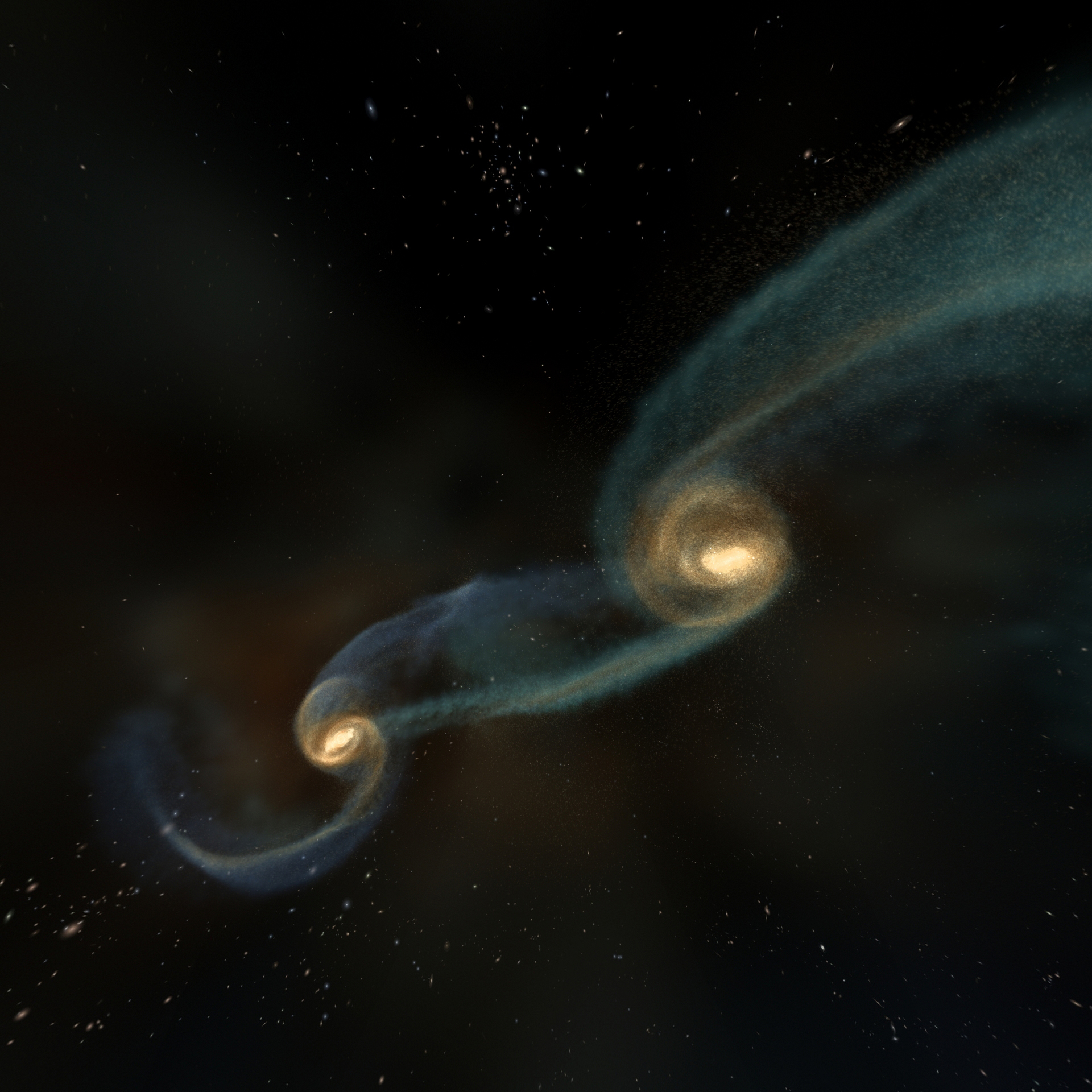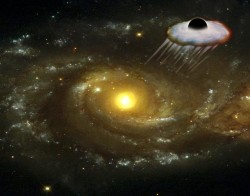For the first time, the most extreme collision to occur in the cosmos has been observed. Galaxies are known to hide supermassive black holes in their cores, and should the galaxies collide, tidal forces will cause massive disruption to the stars orbiting around the galactic cores. If the cores are massive enough, the supermassive black holes may become trapped in gravitational attraction. Do the black holes merge to form a super-supermassive black hole? Do the two supermassive black holes spin, recoil and then blast away from each other? Well, it would seem both are possible, but astronomers now have observational evidence of a black hole being blasted away from its parent galaxy after colliding with a larger cousin.
Most galaxies in the observable universe contain supermassive black holes in their cores. We know they are hiding inside galactic nuclei as they have a huge gravitational dominance over that region of space, sucking away at stars orbiting too close. Recent observations of galactic cores show quickly rotating stars around something invisible. Calculating the star orbital velocities, it has been deduced that the invisible body they are orbiting is something very massive; a supermassive black hole of hundreds of millions of solar masses. They are also the source of bright quasars in active, young galaxies.
Now, the same research group who made the astounding discovery of the structure of a black hole molecular torus by analysing the emission of echoed light from an X-ray flare (originating from star matter falling into the supermassive black hole’s accretion disk) have observed one of these supermassive black holes being kicked out of its parent galaxy. What caused this incredible event? A collision with another, bigger supermassive black hole.
Stefanie Komossa and her team from the Max Planck Institute for extraterrestrial Physics (MPE) made the discovery. This work, to be published in Astrophysical Journal Letters on May 10th, verifies something that has only been modelled in computer simulations. Models predict that as two fast-rotating black holes begin to merge, gravitational radiation is emitted through the colliding galaxies. As the waves are emitted mainly in one direction, the black holes are thought to recoil – much like the force that accompanies firing a rifle. The situation can also be thought of as two spinning tops, getting closer and closer until they meet. Due to their high angular momentum, the tops experience a “kick”, very quickly ejecting the tops in the opposite directions. This is essentially what two supermassive black holes are thought to do, and now this recoil has been observed. What’s more, the ejected black hole’s velocity has been measured by analysing the broad spectroscopic emission lines of the hot gas surrounding the black hole (its accretion disk). The ejected black hole is travelling at a velocity of 2650 km/s (1647 mi/s). The accretion disk will continue to feed the recoiled black hole for many millions of years on its journey through space alone.
Supporting the evidence that this is indeed a recoiling supermassive black hole, Komossa analysed the parent galaxy and found hot gas emitting X-rays from the location where the black hole collision took place.
Now Komossa and her team hope to answer the questions this discovery has created: Did galaxies and black holes form and evolve jointly in the early Universe? Or was there a population of galaxies which had been deprived of their central black holes? And if so, how was the evolution of these galaxies different from that of galaxies that retained their black holes?
It is hoped that the combined efforts of observatories on Earth and in space may be used to find more of these “superkicks” and begin to answer these questions. The discovery of gravitational waves will also help, as this collision event is predicted to wash the Universe in powerful gravitational waves.
Source: MPE News



Wow, Ian, you posted this story within just a few minutes of mine! I’ll be sure to link to yours. You’ve got some stuff written up that I don’t, but I’ve got some good stuff too.
Incidentally, it isn’t the star orbital velocities that allow them to calculate its relative speed; this thing is 10 billion light years away, so they can’t resolve individual stars. But it’s still an amazing event nonetheless!
It that the actual picture? Floating on a cloud zipping away from galaxy only a few times bigger than itself?
This must mean black hole = angels.
(Before anyone yells at me this was sarcasm…)
So when the Adromeda galaxy collieds with our galaxy, our blackhole gets kicked out? Or Adromeda’s?
Jeez, this research group is hogging more than their fair share of the impressive discoveries for the moment, aren’t they?!
“# Shepard Says:
April 29th, 2008 at 9:47 pm
So when the Adromeda galaxy collieds with our galaxy, our blackhole gets kicked out? Or Adromeda’s?”
Assuming that one actually did get kicked out and they didn’t just settle into a nice little orbit around each other and eventually merge, I’d say that that which one got boosted out would depend on the relative masses of each BH, their spins and the particular way in which they encounter each other.
Is this model an explanation why we can’t find a central black hole in M33, the LMC or SMC? Curious.
Welcome to billiards in space. spin, applied momentem (english) – or is it air-hockey?
Looking at the background galaxies in this picture, it looks
like there is some interesting lensing going on here. For
instance take a look at the lower right-hand corner of the
image.
thats not a black hole being kicked out of the galaxy, it looks more like monkey magic on his fluffy cloud of wrath
The Andromeda Galaxy has TWO black holes at its center, which means that at some time in the distant past, it had a collision with another galaxy and essentially “won”.
By the way, that “artwork” of a black hole flying out of a galaxy is terrible. It looks like some amateur quickly slapped something together. Whoever put that out should be embarassed – plus he or she took away a job from a real space artist who could no doubt do a much better job.
So when the Adromeda galaxy collieds with our galaxy, our blackhole gets kicked out? Or Adromeda’s?
Ohh yeah? I bet my galaxies black hole could beat up your galaxies black hole!
This mean that there could be million solar mass black holes flying through the universe. I’ve read about large star black holes being flung out of a galaxy but never the central core black hole. One more thing to worry about.
All these can be explained without massive
black holes or dark matter.
See a hint at my web at cosmicdarkmatter.com
G’day from the land of ozzzzzzzzz
The process of black holes been kicked out is questionable. The normal process is that stellar black holes form within the envelope of the galaxy and in time move towards the centre. During this process it will merge with other stars and black holes growing larger and larger until there is one huge one formed. Supermassive BH can eject matter in huge amounts and large stellar black holes can form in these supermasssive jets and it would seem they have been kicked out. It may be possible for stellar black holes to be caught in the jet stream.
Compact matter can form very quickly as a result of a supernovae, eg Neutron star with 10^17 Kg/m3. Ejected matter via jets may do the same.
Kindly do send me this information regularly. I request, in particular, some information about SPACE in relation to the Big Bang theory -the illogical and skin-saving “singularity ” of the big bang or the big inflation did require matter with mass although infinitely compressed, infinitely hot etc. Now, when this thing exploded or inflated, was there already space in existence or the expanding matter created automatically the space required for inflated matter AS WELL AS ALL THAT EXTRA LEG ROOM REQUIRED FOR CONTINUOUS FURTHER EXPANSION AND SPACE BETWEEN GALAXIES ETC. ETC? I am curious to read some brilliantly thought out explanations with countless singularities (if required) for SPACE. I believe that SPACE is not matter, nor energy, gravity etc. Also, How does gravitation force first compress the big-bang matter infinitely and then let go in a bang to such as an extent that the resultant matter/mass is constantly expanding and distancing itself from other such groups/galaxies etc.? Kindly help. Thank you.
Kindly permit me to ask why we should assume that these galaxies are running away from one another because of big bang explosion/inflation, === could they not be ATTRACTED by some other gravitational forces located in the infinite universe? In any case, it seems to be accepted that for some peculiar reason the explosion/inflation has pushed away its constituent matter in all directions (not only in a spiral disk}. In an infinite universe, there can be no centre, west, east etc.